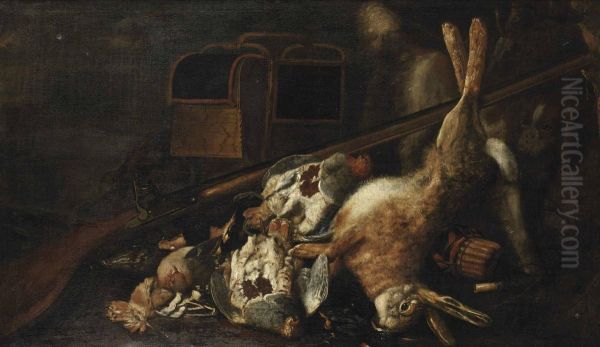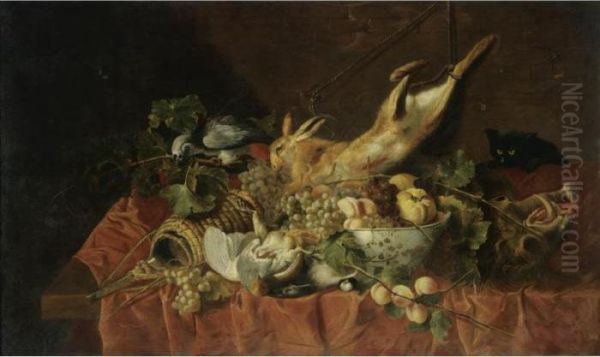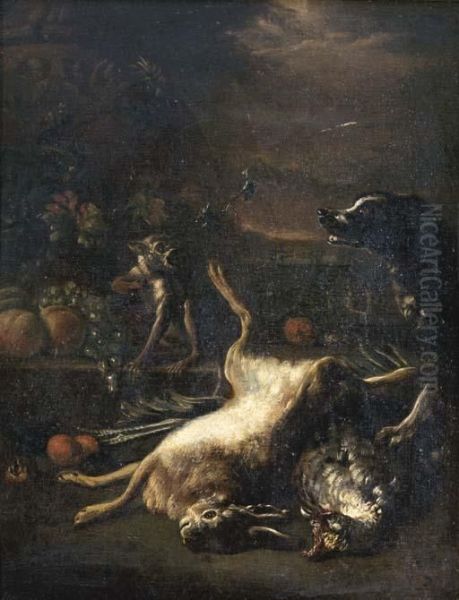An Introduction to the Artist
Jan Fyt, born Johannes Fijt, stands as one of the most accomplished and influential Flemish Baroque painters of the 17th century. Active primarily in Antwerp, the vibrant artistic hub of the Southern Netherlands, Fyt carved a distinct niche for himself, specializing in breathtakingly detailed and dynamic depictions of animals, hunting scenes, and opulent still lifes. His work, characterized by technical brilliance, rich textures, and dramatic compositions, earned him considerable fame during his lifetime and secured his legacy as a pivotal figure in the development of animal and still life painting in Europe. He navigated the rich artistic milieu of his time, learning from masters, collaborating with peers, and ultimately forging a unique style that continues to captivate viewers centuries later.
Early Life and Artistic Formation in Antwerp
Jan Fyt was baptized in Antwerp on March 15, 1611. He hailed from a relatively prosperous background; his father was a wealthy merchant, which perhaps afforded him the opportunity to pursue an artistic career. His formal training began relatively early. Records suggest he initially apprenticed with Hans van den Bergh, a lesser-known painter, around 1621. This initial training would have provided him with the foundational skills necessary for a painter in the competitive Antwerp environment.
However, the most significant phase of his education commenced shortly thereafter when he entered the prestigious workshop of Frans Snyders. Snyders was already the preeminent master of animal painting and large-scale market and pantry scenes in Flanders, working frequently with giants like Peter Paul Rubens. Fyt is documented as an apprentice and assistant in Snyders' studio from roughly 1621 until 1631. This decade under Snyders' tutelage was crucial, immersing Fyt in the techniques and thematic concerns that would define his career.
By 1629 or 1630, Fyt achieved the status of an independent master, being officially registered in the Antwerp Guild of Saint Luke. This professional guild membership granted him the right to establish his own workshop and take on pupils. Despite becoming a master in his own right, evidence suggests he may have continued to work within Snyders' orbit for a couple more years, likely contributing to the large commissions handled by his former master's studio while honing his individual approach.
The Enduring Influence of Frans Snyders

The impact of Frans Snyders on Jan Fyt's artistic development cannot be overstated. Working closely with the leading animal painter of the era provided Fyt with unparalleled training in capturing the anatomy, movement, and textures of various creatures, both live and dead. Snyders' grand, often tumultuous compositions, filled with an abundance of game, fowl, dogs, and luxurious foodstuffs, set a high standard for the genre.
Fyt absorbed Snyders' mastery of depicting hunting trophies – dead hares, birds, deer – often arranged in dramatic, sprawling displays. He learned how to render the sheen of feathers, the softness of fur, and the muscular tension of hunting dogs with convincing realism. Early works by Fyt clearly show this stylistic debt, adopting similar subjects and compositional structures.
However, Fyt was not merely an imitator. As he matured, he developed a distinct artistic personality. While Snyders often favored monumental scale and a certain robust energy, Fyt increasingly focused on refinement, elegance, and a more intimate observation of detail. His brushwork, often described as combining the bravura associated with Rubens with a sensitivity reminiscent of Rembrandt van Rijn's handling of light and texture, became more fluid and delicate. He achieved a remarkable ability to differentiate textures, making fur seem palpably soft and feathers almost weightless. His compositions, while still dynamic, often possess a greater sense of controlled arrangement and atmospheric depth compared to the sometimes overwhelming abundance in Snyders' work.
Travels and Broadening Horizons: Paris and Italy
Seeking to broaden his artistic experience and perhaps establish international connections, Jan Fyt embarked on extensive travels beginning around 1633. His first significant stop appears to have been Paris, a major cultural center. While details of his activities there are scarce, it is likely he studied the works of French artists and absorbed the prevailing artistic trends in the French capital.
Following his time in Paris, Fyt journeyed south to Italy, the ultimate destination for ambitious Northern European artists seeking to immerse themselves in classical antiquity and the masterpieces of the Italian Renaissance and Baroque. He is documented as working in Italy for several years, likely between 1634 and 1641. His travels took him to key artistic centers, including Venice, renowned for its colorito and atmospheric painting, particularly the works of Titian and Tintoretto.

He also spent considerable time in Rome, the heart of the Baroque movement. In Rome, Fyt became associated with the Schildersbent (or Bentvueghels), a society of primarily Dutch and Flemish artists living and working in the city. Known for their bohemian lifestyle and mutual support, members adopted nicknames or "bent" names. Fyt was given the moniker "Goudvink" (Goldfinch), a testament perhaps to his vibrant palette or his perceived value within the group. His time in Rome would have exposed him directly to the dramatic realism of Caravaggio and his followers, as well as the classical compositions of artists like Annibale Carracci and the flourishing genre of Roman still life painting. Evidence also points to stays in Naples and Florence, further enriching his visual vocabulary. These Italian experiences undoubtedly refined his sense of composition, light, and perhaps introduced a warmer tonality to his palette. He also reportedly visited the Northern Netherlands before finally returning to his native Antwerp.
Artistic Style: Baroque Dynamics and Meticulous Detail
Jan Fyt's mature style is a masterful synthesis of Flemish Baroque energy and meticulous observation. His paintings are immediately recognizable for their focus on animals, hunting paraphernalia, and still life elements, rendered with extraordinary technical skill. He excelled in capturing the textures of his subjects – the rough fur of a hound, the iridescent plumage of a pheasant, the smooth skin of fruit, the cold gleam of metal hunting horns.
His compositions are typically dynamic, often employing diagonal lines and contrasting forms to create a sense of movement and vitality, even when depicting dead game. This dynamism is a hallmark of the Baroque era, influenced by the dramatic intensity found in the works of Peter Paul Rubens. Fyt masterfully used light and shadow (chiaroscuro) to model forms, create depth, and highlight key elements within the scene, lending his works a theatrical quality.
While inheriting the subject matter of the hunt and opulent still life from Snyders, Fyt brought a greater sense of refinement and psychological nuance, particularly in his depictions of live animals. His hunting dogs are not merely accessories to the scene but often convey alertness, weariness, or predatory focus. His palette is rich and varied, capable of rendering both the vibrant hues of exotic birds and the subtle earth tones of game animals and forest floors. He often combined elements, placing carefully arranged still lifes of fruit or dead game within landscape settings or against architectural backdrops, creating complex and visually engaging narratives.
Unrivaled Mastery in Animal Depiction
Perhaps Jan Fyt's most celebrated achievement lies in his extraordinary ability to depict animals. He possessed a profound understanding of animal anatomy, likely honed through direct observation and sketching. This anatomical accuracy provided the foundation for his lifelike portrayals, whether capturing the coiled energy of a hunting dog straining at the leash or the limp stillness of a recently killed hare.

He was particularly renowned for his rendering of textures. Few artists before or since have matched his skill in differentiating the feel of various types of fur – the coarse coat of a wild boar, the sleek pelt of a deer, the soft downy fur of a rabbit. Similarly, his depiction of feathers was exceptional, capturing their intricate patterns, delicate structure, and the play of light across their surfaces. This tactile quality invites the viewer to almost feel the textures represented.
Dogs feature prominently in Fyt's oeuvre, especially hunting hounds. He depicted various breeds with remarkable specificity, capturing not only their physical characteristics but also their characteristic poses and expressions. His dogs often serve as active participants in the scene, interacting with the game or gazing intently out of the canvas, adding a layer of narrative and emotional engagement. This focus and skill elevated animal painting beyond mere decoration, showcasing the inherent beauty and character of the creatures themselves.
Representative Works: A Glimpse into Fyt's World
Jan Fyt was a prolific artist, and numerous works survive, housed in major museums and private collections worldwide. Some of his key representative paintings include:
Dead Birds with Dog (Aves mortas com cão): Located in the Kunsthistorisches Museum, Vienna, this work exemplifies his skill in arranging game trophies alongside a watchful hound, showcasing his mastery of texture and composition.
Hounds with Dead Game: Housed in the Musée du Louvre, Paris, this painting highlights his ability to create dynamic interactions between hunting dogs and their quarry, set within a landscape that adds atmospheric depth.
Hunter's Backpack Still Life: This type of composition, featuring game (like a hare and birds) spilling from a hunter's bag alongside fruit or vegetables, demonstrates his ability to combine different elements into a rich, unified whole. Variations exist in several collections.
Hunting Hawk and Tools (or Falcon and Hunting Equipment): Found in the Museu Nacional de Soares dos Reis, Porto, and potentially related works like one in the Bratislava City Gallery, these paintings focus on the aristocratic pursuit of falconry, depicting the noble birds alongside hoods, lures, and game bags with meticulous detail.
Two Dead Dachshunds: An example of his focus on specific animals, showcasing his ability to render even deceased creatures with dignity and remarkable realism.
Still Life with Hare, Partridges, and Fruit: Held by The Metropolitan Museum of Art, New York, this work is typical of his opulent still lifes, combining game animals with luscious fruit in a carefully balanced, richly textured arrangement.
Still Life with Rabbit: Located in the Museum of Fine Arts, Budapest, this painting likely focuses on a central game element, rendered with Fyt's characteristic attention to detail and texture.
Vos’s Pantry (in collaboration with Paul de Vos): This work highlights Fyt's collaborative nature. Paul de Vos, another prominent animal painter (and brother-in-law of Frans Snyders), likely worked alongside Fyt, combining their respective strengths.
These examples illustrate the recurring themes in Fyt's work: the bounty of the hunt, the beauty and vitality of animals (especially dogs and birds), and the luxurious display of nature's offerings, all rendered with unparalleled technical finesse.
Collaborations, Connections, and Contemporaries
The Antwerp art scene in the 17th century was highly collaborative. It was common practice for artists specializing in different genres to work together on a single canvas. Jan Fyt participated actively in this environment. His primary connection, of course, was with his teacher, Frans Snyders. Even after establishing his independence, their careers remained intertwined through shared subject matter and the competitive, yet connected, Antwerp market.
Fyt is known to have collaborated with figure painters, who would add human staffage to his landscapes or still lifes, while Fyt, in turn, might add the animals or still life elements to their compositions. Although specific documented instances for all potential collaborators are sometimes debated, he is believed to have worked with artists such as Jacob Jordaens, a leading figure painter alongside Rubens, and possibly members of Rubens's extensive workshop. Some sources suggest Fyt provided animal studies or painted animals directly into works by Peter Paul Rubens himself, though the exact nature of this interaction is complex given Rubens's own skills and workshop practices.
He certainly collaborated with fellow animal painter Paul de Vos, as evidenced by works like Vos's Pantry. He also worked alongside prominent painters like Thomas Willeboirts Bosschaert and Erasmus Quellinus II, who often painted figures or mythological scenes that Fyt would embellish with his signature animals or still life details. His relationship with David Teniers the Younger, another hugely successful Flemish painter known for his genre scenes, was likely more one of market competition, as their primary specializations differed significantly. Fyt's student, Pieter Boel, became a notable animal and still life painter in his own right, sometimes collaborating with his master. Another contemporary specializing in similar themes was Adriaen van Utrecht. Fyt's travels also brought him into contact, directly or indirectly, with Italian still life traditions, potentially influencing or being influenced by artists like Giuseppe Recco or Giovanni Battista Ruoppolo in Naples.
Workshop, Students, and Teaching
Like most successful masters of his time, Jan Fyt operated a workshop in Antwerp after his return from Italy around 1641. Having assistants and students allowed him to increase his output and disseminate his style. While the full extent of his workshop activities is not perfectly documented, several pupils are known.
The most significant of these was Pieter Boel (1626–1674). Boel studied with Fyt and became a highly accomplished painter of animals and still lifes, clearly absorbing his master's techniques for rendering textures and creating dynamic compositions. Boel's own success, later working for King Louis XIV at the Gobelins Manufactory in Paris, speaks to the quality of training received under Fyt.
Other documented students include Jaques van de Kerckhove (also known as Jacob van der Kerckhoven, often cited as Jaques de Verkeer), who also specialized in still lifes and animals, and Jeronimus Pinckertoon. The presence of these students indicates that Fyt actively engaged in teaching, passing on his specialized knowledge and contributing to the continuity of the animal and still life tradition in Flemish art. His influence extended beyond his direct pupils, impacting the direction of the genre throughout the latter half of the 17th century.
Later Life in Antwerp and Legal Entanglements
After returning from his extensive travels around 1641, Jan Fyt settled permanently in Antwerp, where he remained a highly respected and productive artist for the rest of his life. He continued to receive commissions and his works were sought after by collectors both locally and internationally. His reputation as the leading animal painter after the death of Frans Snyders in 1657 was firmly established.
Despite his artistic success, Fyt's later life was not without complications. Court records from Antwerp reveal that he was involved in several legal disputes. These cases reportedly involved disagreements with fellow artists, patrons, and even members of his own family. While the specific details of these disputes are often unclear, they paint a picture of a successful artist navigating the sometimes contentious professional and personal relationships within the competitive Antwerp art world. These legal entanglements, however, do not seem to have significantly hampered his artistic output or diminished his reputation during his lifetime. He continued to paint prolifically until his death.
Jan Fyt passed away in Antwerp on September 11, 1661, at the relatively young age of 50. He left behind a substantial body of work and a significant artistic legacy.
Legacy, Influence, and Collections
Jan Fyt's influence on the course of European art, particularly in the realms of animal painting and still life, was profound and lasting. He elevated the genre beyond mere decorative depictions, infusing his subjects with vitality, texture, and a sense of drama characteristic of the High Baroque. His technical innovations, especially in the rendering of fur and feathers, set a new standard that inspired subsequent generations of artists in Flanders and beyond.
His impact was felt not only by his direct pupils like Pieter Boel but also by numerous other Flemish painters who adopted elements of his style. Furthermore, his works, which were collected across Europe, are credited with influencing the development of still life painting in Italy and possibly Spain. His detailed realism combined with Baroque dynamism offered a compelling model for artists exploring similar themes.
Today, Jan Fyt's paintings are held in the collections of virtually every major museum with holdings in Old Master paintings. Prominent examples can be found in the Prado Museum in Madrid, the Musée du Louvre in Paris, the Kunsthistorisches Museum in Vienna, the Alte Pinakothek in Munich, the Gemäldegalerie in Berlin, the Hermitage Museum in St. Petersburg, The Metropolitan Museum of Art in New York, the National Gallery in London, the Rijksmuseum in Amsterdam, the Museum of Fine Arts in Budapest, the Museu Nacional de Soares dos Reis in Porto, and many others. His continued presence in these prestigious institutions, alongside significant prices achieved for his works when they appear at auction, underscores his enduring importance in the history of art.
Conclusion: An Enduring Master of Fauna and Finery
Jan Fyt remains a towering figure in Flemish Baroque art. As a student of the great Frans Snyders, he inherited a rich tradition of animal and still life painting, but he quickly forged his own path. Through extensive travel, keen observation, and exceptional technical skill, he developed a unique style characterized by dynamic compositions, meticulous detail, unparalleled textural rendering, and a sophisticated understanding of light. His depictions of the hunt, game trophies, live animals – particularly dogs – and opulent still lifes captured the spirit of his age while showcasing his individual genius. His collaborations, his role as a teacher, and the wide dissemination of his works cemented his influence across Europe. Jan Fyt's legacy endures in the numerous masterpieces housed in museums worldwide, continuing to impress viewers with their vibrant energy and breathtaking realism.